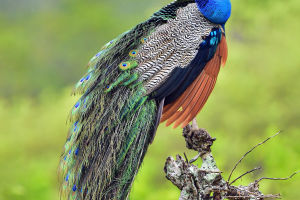The Emperor penguin (scientific name: Aptenodytes forsteri) stands as the largest member of the penguin family, boasting an average height exceeding 90 cm and a weight reaching up to 50 kg, with some individuals even surpassing 120 cm.
Its striking appearance is characterized by an orange-yellow feathering at the base of the neck, gradually fading downward and intensifying behind the ears.
The whole body is color-coordinated, featuring a pale yellow neck, bright yellow-orange ear feathers, a creamy white belly, and black back and finned limbs. The distinctive underside of the beak exhibits a bright orange hue.
Emperor penguins endure the harsh Antarctic winters, breeding on the ice where the female lays one egg at a time. Notably, the male emperor penguin assumes the responsibility of incubating the eggs. A unique feature of male emperor penguins is the vascular, purple-skinned nursery pouch situated between their legs and the underside of their abdomen. This pouch serves the vital function of maintaining the eggs at a comfortable 36 degrees Celsius, even in ambient temperatures plummeting as low as -40 degrees Celsius.
Displaying a remarkable adaptation to severe weather conditions, emperor penguins exhibit herd behavior, huddling together to shield themselves from the biting wind and cold. Their remarkable diving abilities enable them to explore the depths of the ocean, with recorded dives ranging from 150 to 500 meters and an exceptional dive documented at an astounding 565 meters. Their diet primarily consists of crustaceans, with occasional forays into consuming small fish and squid. As the only penguin species breeding in Antarctica during winter, Emperor penguins are exclusively found in Antarctica and its surrounding islands.
Distinguishing within the same genus, the King penguin shares similarities in appearance with the Emperor penguin. Despite these resemblances, they are distinct species with notable differences. One significant dissimilarity lies in their size, with Emperor penguins reaching up to 50 kg, while King penguins are notably smaller, typically weighing between 15-16 kg. The King penguin boasts a longer and more slender beak in contrast to the Emperor penguin, distinguishing their remarkable anatomical variations. Notably, the orange part of the King penguin's neck extends downward and backward over a larger area than its Emperor counterpart.
Beyond physical attributes, Emperor penguins inhabit a higher latitude, ranging from 66 to 78 degrees south, while King penguins are found at comparatively lower latitudes.
Penguins, as quintessential seabirds, showcase exceptional swimming prowess. Although flight eludes them, their webbed feet function as rudders for direction control in water. Unlike many waterfowl that use webbed feet for paddling, penguins propel themselves through the water using oar-like wings. Their rapid swimming abilities are impressive, with Emperor penguins covering around ten kilometers per hour and the white-tipped penguin holding the record for swimming at an astounding 36 kilometers per hour.
Penguins, the unrivaled champions of diving among birds, employ a distinctive swimming technique reminiscent of dolphins, seamlessly diving for impressive distances, resurfacing for a quick breath of air, and effortlessly diving once more. This remarkable ability stems from an evolutionary choice between flight and underwater agility. Over time, as wings became more adept for diving, the necessity for flight diminished, leading to the adaptation of wings into fin-like limbs.
In conclusion, understanding the nuances between Emperor penguins and King penguins extends beyond mere visual similarities. Their unique characteristics, habitats, and evolutionary adaptations highlight the fascinating diversity within the penguin family.


